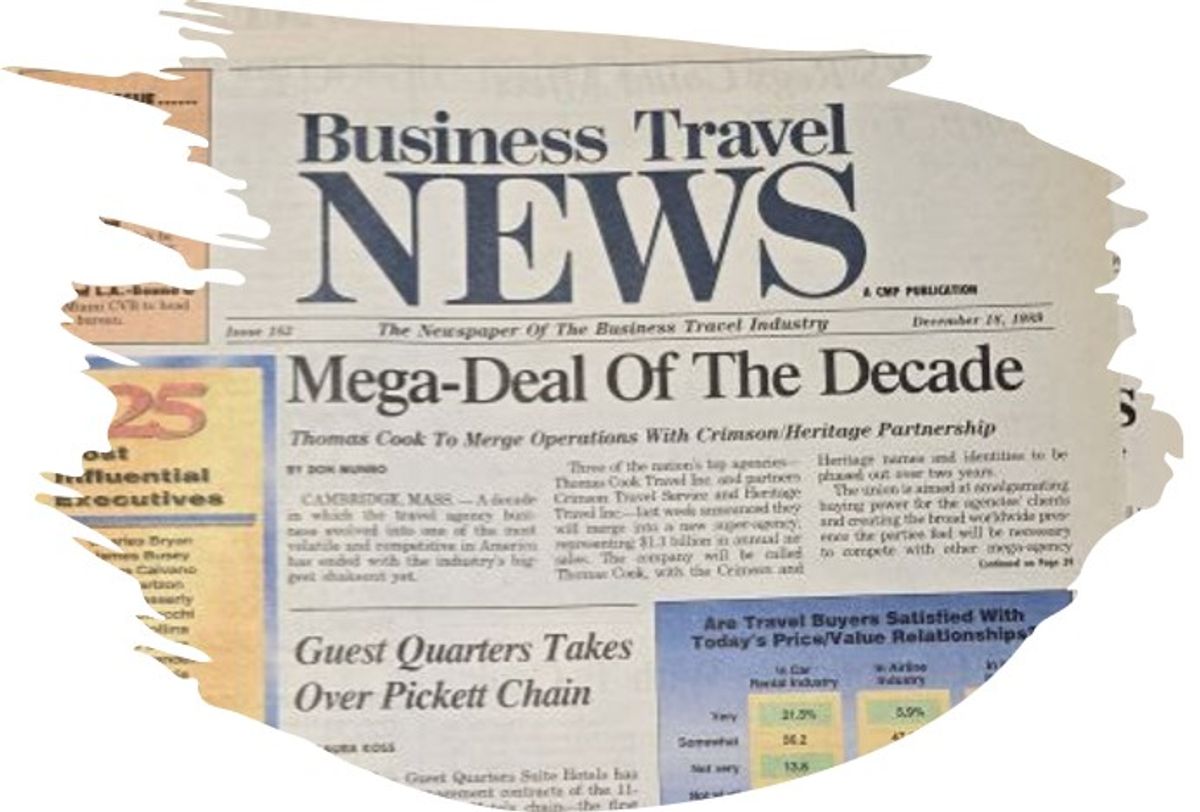Travel
1989: Corporates Gain Power

Business Travel News’ fifth birthday year 1989 was pivotal
for the business travel industry, with corporates seemingly gaining power and
the industry overall realizing that in order to serve corporate business, you
can’t operate a “business-as-usual” leisure-style agency. Plus, travel suppliers—with
some very interesting exceptions—seem to be coming to the realization that corporate
deals are worth major coin (and steady-as-she-goes revenue streams), even if discounts
are involved.
We should put this on an important backdrop as well. The
U.S. airline industry in 1989—and BTN generally covered only the U.S. market at
this point in its history—was experiencing really complex dynamics that would
take volumes to dissect. Suffice to say that profitability was dropping—indeed,
cratering. Though passenger revenue came in 6.8 percent higher than in 1988, the
airline industry’s overall net profit was just $190 million that year, compared
to nearly $1.7 billion the prior year, a drop of nearly 89 percent. The average
profit margin came in at 0.3 percent compared to an average of 2.6 percent the
year prior and a 5.5 percent profit margin for all U.S. industry in 1989. This
is all according to the Air Transport Association annual reports from 1989 and
1990, each of which offers the financial summaries of the previous year. This
was the last profit the industry would see for six years.
This drop was amid a long strike against Eastern
Airlines and rising jet fuel prices, which would only get higher in 1990 with
the onset of the Iraq war. It offers context, though, to the numerous rounds of
rate hikes in 1989 that you can see throughout the timeline below. It might
also offer context to the airlines’ relative coolness to corporate discounts as
crystalized by American Airlines’ chief executive Bob Crandall, who told the
members of the newly-re-christened National Business Travel Association during its August convention that discounting for business travelers “would be
dumb.”
Thanks to Southwest Airlines, which really began to
flex its low fares on some new U.S. routes, some of the planned airline rate
hikes were patchwork in nature and some were quickly rolled back in certain
markets in order for legacy airlines to stay competitive. Toward the tail end
of the year, however, airlines were broadly considering more fare hikes (see United
Airlines’ move in December) and debating the benefits of either rolling hikes
into the fares themselves or accounting for them as fuel surcharges.
But if the struggling airline industry was tagging corporate
discounts as “dumb” (and not all of them were), that wasn’t apparently the case
for other supplier categories and definitely not for travel agencies which were
courting new clients with upfront rebates and realizing that they actually
needed to restructure entire businesses to serve this reliable segment of the
travel industry.
Let’s look at interesting supplier moves first. In my
mind, the most remarkable item in the list of suppliers’ changing attitudes
toward corporates would be Hyatt Hotels’ concession to do a systemwide discount
deal with Philip Morris. The tobacco giant was clearly a big-dollar account,
but this deal breaks down a wall to a model that we are still working with
today: negotiate key discounts in high-volume cities and work with the national
account representatives to work out a broader but more limited deal across the
rest of the portfolio. Hyatt had 98 hotels in the U.S. in 1989—times have definitely
changed, but this corporate discount model has proved sticky.
Another interesting move, this time from Northwest Airlines,
looks decidedly modern in its strategy to attract midmarket clients. The airline
created a discount program specifically for accounts that spent $1 million to
$5 million annually with the carrier. Airlines today have very similar
programs, and hotels this year and last rolled out SME programs one after another
to attract that lucrative midmarket client. I’ll acknowledge that a $1 million
to $5 million client in 1989 would be a $2.5 million to $12.7 million client
today. That’s pretty much exactly the range BTN defines as a midmarket client in
2024, in terms of U.S.-originating air spend.
Moving on to intermediaries, which were incredibly
interesting in 1989 (if you are a super geek, which I admittedly am). Another “modern”
move, which I loved to see pop up in the timeline, was Northbrook, Ill.-based IVI
Travel’s foray into the corporate card business. Genius! The partnership with
First Bank System Card Services in Minneapolis was for a joint Visa Business
Card that would enable IVI to participate in interchange fee revenue and provide
payment data to clients. The industry seemed to blow it off—I’ll update you
with more details as we journey through history together. But the point is, IVI
wanted to attract corporate business by delivering more value and competing with American
Express Travel Services in the card game. Perhaps because it couldn’t compete in
terms of size with the $2.2 billion mega-agency, and they weren’t the only ones
looking to compete on that level.
McDonnell Douglas Travel went for the straight-up
rebate to finally put the Spectrum Group in the agency’s client portfolio. It had
been courting that program for a number of years, according to BTN reports at
the time.
It’s Ask Mr. Foster, Lifeco and Woodside, however,
who realized that their business structures were holding them back. Woodside
was struggling to compete because it had limited its members to regional
exclusivity, not realizing when it did so, that corporate accounts—as opposed
to leisure business—required footprint underneath a single umbrella. Limiting
its agencies to a regional footprint might give them great market share in
their region, but it was a bust for the demands of corporate. In 1989, they
ditched the regional limitations for members.
It may have already been too late though—the industry
was already outgrowing even “national” agencies and looking for global partners.
Lifeco was on the hunt for that global footprint, buying its first agency
outside the U.S. and revealing plans to expand into five European countries and
eventually to Asia. (The U.S. and Japan’s bilateral agreements to expand airline
access between the two countries was additional evidence in how quickly globalization
was taking hold.)
Ask Mr. Foster realized that leisure and business
travel clients had to be treated with separate strategies. It created a separate
division for corporate business and consolidated back-office operations in Minneapolis.
The agency cited the advancing sophistication of the business travel client
with “more client contracts, more on-sites and in-plants, more satellite ticket
printers” driving the decision.
It was the final BTN issue of the year, however, that
revealed the real urgency among agencies to win clients and compete with global
footprint and the ability to deliver value with volume.
A very large headline on the Dec. 18 issue reads, “Mega-Deal
of the Decade.” Thomas Cook combined with partners Crimson/Heritage to consolidate
under the Thomas Cook name with an estimated $1.3B in air sales. While the play
didn’t exactly put it on par with American Express Travel Related Services,
which claimed $2.2B in air bookings in 1989, it put Thomas Cook, which had been
acquired by British publishing magnate Robert Maxell earlier in the year, in a
different stratosphere for serving corporate travel clients.
There’s so much more happening in 1989, including the first meeting of the now defunct Association of Corporate Travel Executives—enjoy reading!
_______________________________________________________________________

_______________________________________________________________________

USTravel Systems makes two moves seen as new threats to the future of
travel agency consortia. It makes a bid accepted one month later to purchase Associated
Travel, and it buys Hickory Travel Systems Houston, a key member of
the Hickory Consortium.
Several agricultural groups cancel a convention
scheduled for San Francisco after the city passes a resolution supporting a
boycott on the purchase of table grapes because of allegedly dangerous
pesticides used on them.
Avis sells a stake in the company to General Motors.

Northwest Airlines quietly plans to begin offering across the board
discounts to selected corporations with air volumes of $1M-$5M
American Airlines and Delta agree to form a new, independently
managed company to jointly own and market their respective reservation systems,
which ultimately will be merged.
Dun & Bradstreet sells Thomas Cook USA to
British publisher Robert Maxwell, ending Lifeco Services’ dream of
swallowing up the giant New York based agency,
Citicorp Information Management systems disbands its
automated hotel and car rental reservation system (ARMS), putting pressure on IVI
Travel, Woodside and Hickory to find replacements for the services
CIS provided.
ACTE holds its first industry conference. The event
leaves the young group with an ambitious agenda and a heavy debt load.

Eastern AirlinesMechanics Union makes good on its threat to
strike after contract negotiations fail, and most of the airline is grounded. Companies
in Eastern strongholds lack airlift. Within a few weeks, Delta and other
carriers pick up much of the slack. Eastern later files for bankruptcy nearly
sells out but is pulled off block by parent Texas Air, which vows to restart
operations in scaled down form.
FAA lays plans to require that jet aircraft parts be
repaired after a specific number of years or flights. In doing so, the agency
takes a more active role in maintenance decisions previously left to airlines
and airplane manufacturers.
Federal Communications Commission cracks down on the high
rates and certain unfair practices of so-called alternative operator services,
which provide long distance telephone services to hotels and airports.

American Airlines catches two travel agencies abusing corporate meeting
details deals and collects at least 30,000 in back airfares at the same time, Delta cancels a meetings fare deal with General Dynamics, which allegedly
abused terms of its pact.
A bid by Denver oil man Marvin Davis to buy Northwest
Airlines for $2.7B is rejected, but Davis vows to proceed with a hostile
takeover attempt.
Ramada sells its struggling hotel group to New World
Development of Hong Kong for $550 million. Prime Motor Inns pays New
World $180M to manage Ramada’s U.S. franchise operations.
Scandinavian Airlines System buys a 40 percent stake in Intercontinental
Hotels for $500M.

Word gets out that ACTE is having serious
problems with finances and staffing. ACTE’s guiding force Peter Jensen pins the blame on his own overambitious planning. Two weeks later, Jensen dies in
a fire at his home.
Thrifty Rent-A-Car becomes the latest car rental company to be
swallowed up by a U.S. automaker in this case Chrysler Corp.
Airlines serving West Coast routes fight out a fare
war as low-cost operator Southwest Airlines prepares to launch service
from Oakland.
John Zeeman leaves his post as executive marketing VP at United to
take the reins at Galileo, further establishing the developing European
CRS vendor as a major force.

Justice Department puts the kibosh on the proposed CRS merger of American
Sabre and Delta’s DATAS II.
Northwest Airlines dashes hopes of Pan Am and Marvin Davis by choosing the purchase bid of Los Angeles investor Alfred Checchi. Objections
by the federal government and the airline unions threaten to snarl the deal.
Confusion reigns as travel agents try to unravel new overseas fare rules set by
the International Air Transport Association. After some initial worry,
it doesn’t look like the changes will cost U.S. corporations
Hickory Travel Systems sends letters to members acknowledging their
dissatisfaction and proposing a radical structural overhaul of the consortium. President
Bernard Barovian, a former travel manager, resigns
IVI Travel gets into the corporate card business to compete with American
Express. Amex and other card vendors say they can’t understand what all the
fuss is about.

United Airlines DC-10 jet crashes making an emergency landing on a Sioux
City, Iowa, runway, killing nearly half of passengers.
McDonnell Douglas Travel offers an upfront rebate in
order to lure the Spectrum Group, A diversified California holding
company, into its realm. The move could break new ground in the way agency
client relationships are structured.
American Airlines stops active marketing of its Capture, travel
expense management system, saying the corporate market is not ready for it.

National Passenger Traffic Association changes its name to the National
Business Travel Association and names Margie Crace, then-corporate
travel manager for Chemed/Dubois in Cincinnati, as president. Crace pursues a “Square
One” agenda that looks to re-engage with the association’s 40-plus regional
affiliate chapters.
American Airlines CEO Bob Crandall says at the NBTA convention that
discounting fares to business travelers “would be dumb.”

American Airlines plans a rate hike across seven- and 14-day advanced
fares, blocking one of the few remaining avenues for corporates to hold down
air travel costs. Delta soon follows. AA says it will cancel the plan if other
airlines don’t come on board.
Delta begins talks with PARS, co-owned by Northwest
Airlines and TWA about a deal that would give Delta’s DATAS II a greater
domestic CRS presence. The two eventually join up to form Worldspan in
1990.
Ask Mr. Foster restructures to establish separate division for
corporate business and consolidating back-office operations in Minneapolis. The
agency cited “more client contracts, more on-sites and in-plants, more
satellite ticket printers” driving the corporate travel business.

Congress bans smoking on domestic flights.
Donald Trump makes a $7.5B bid to acquire American Airlines.
The airline responds that “excess levels of debt in the airline industry are
not in the public interest,” but CEO Bob Crandall seemingly squares up
for a fight. Trump abandons the bid less than two weeks later.
Philip Morris negotiates a systemwide 10 to 15 percent discount
deal with Hyatt Hotels. Until then, Hyatt only made deals on a per
market basis. Philip Morris carved out nine markets for a deeper discount of 10
to 30 percent. Hyatt had 98 hotels in North America at the time.
Massive earthquake rocks the San Francisco Bay area, inflicting heavy
damage on the area’s roads, airports and hotels. The FAA limited air traffic
into the airport, muddling airline timetables across the globe.

Chicago’s O’Hare airport reveals plans to build a new international
terminal. It opened ahead of schedule in 1993.
Lifeco buys London-based Mark Allan Travel Ltd. in
first move to become a wholly-owned global agency. It reveals plans for
additional acquisitions in France, Germany, Spain and Italy.
The U.S. and Japan announce a bilateral
agreement to expand service between the countries to new cities, opening up new
business travel routes.
Prism introduces reports that calculate cost per mile
flown, and with the ability to combine segments on connecting flights; the data
innovation relieves travel managers who have been stitching together segments
and separate cost and miles reports.

United triggers new round of fare hikes on unrestricted
coach fares and first-class fares, citing costs—including a 16 percent rise in
jet fuel costs in Q3—as the driver behind the move.
Woodside consortium restructures in bid to compete with
mega-agencies, ditches territorial exclusivity rules that many industry
observers acknowledged had limited member agencies’ growth potential with
corporates.
Thomas Cook combines with partners Crimson/Heritage.
The trio consolidates under the Thomas Cook name with an estimated $1.3B in air
sales.
_______________________________________________________________________

Elizabeth West is the editorial director of the
BTN Group. She has reported on the business travel and meetings industries for
24 years. Beth was editor-in-chief of Meeting News from 2006 to 2008 and
director of content solutions for ProMedia Travel from 2008 to 2011, when
ProMedia was acquired by Northstar Travel Media and merged with BTN. She became
editor-in-chief of BTN in 2015 and editorial director of the BTN Group in
2019.
_______________________________________________________________________





/cdn.vox-cdn.com/uploads/chorus_asset/file/24435784/tokyostrava.jpg)



